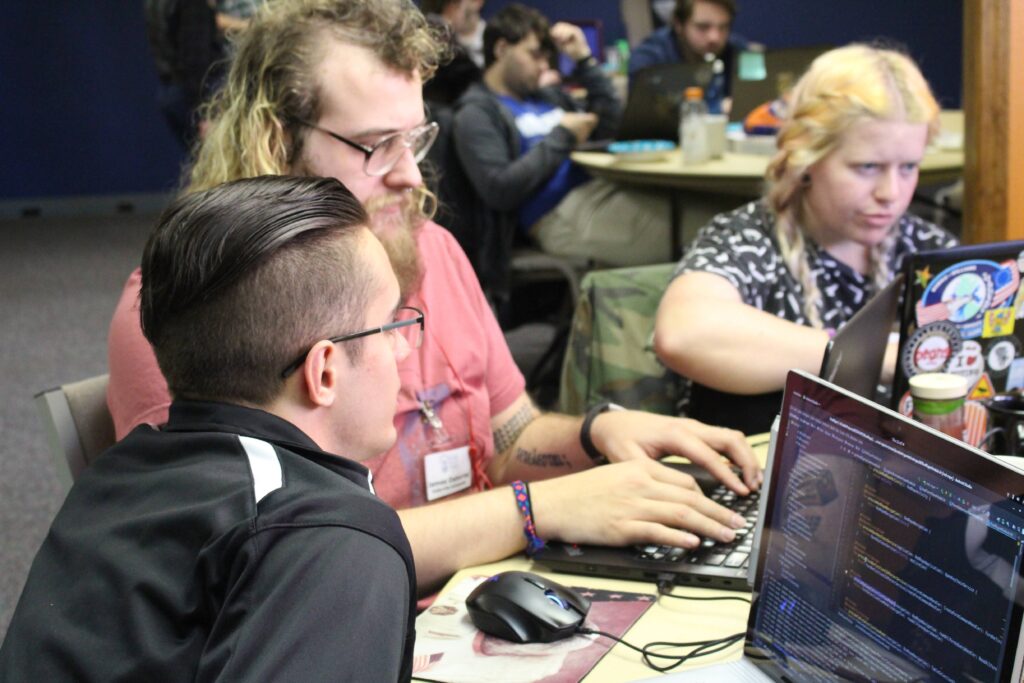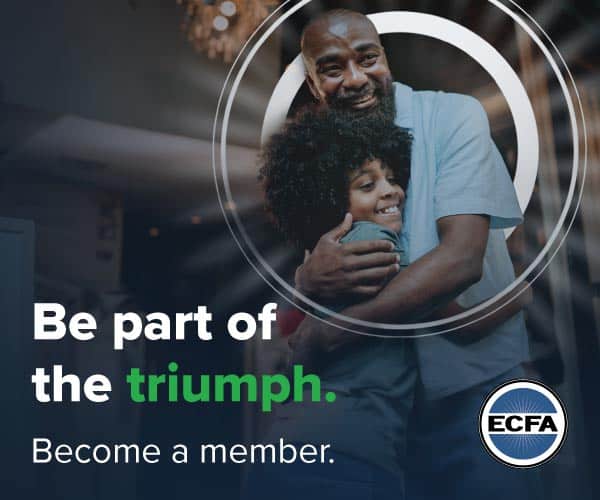EMQ » July–September 2023 » Volume 59 Issue 3

Summary: Over the last 22 years, God has led me on a journey from missions tech skeptic to missions tech recruiter. He has given our ministry the opportunity to share about missions tech needs with thousands of Christian computer science students over the last decade – and then give them opportunities to plug in and see their skills at work. But many of the next generation’s techies still don’t know how critical their work is to the Great Commission.
By Dorinda Beeley
“The number one thing that keeps our mission organization from moving forward with our goals is the lack of qualified computer people,” the CEO said.
We were at the Urbana missions conference in 2015. The CEO of a well-known mission organization had approached the LightSys Technology Services booth in the vendor hall and started up a conversation with me. He was amazed that the primary focus of our small mission organization was to provide computer support for the international missions community.
As we began chatting about the oft-felt computer support pains that are common throughout missions (and all humankind), the CEO began to get excited about our vision at Urbana to mobilize the next generation of computer science geeks to use their computer skills in missions.
“This is such a major need!” he said urgently as he shared about the technology opportunities and needs felt deeply by their mission organization.
Yet that conversation contrasted starkly with countless other conversations – mostly with students – that I had at the same Urbana missions conference.
“I’m studying software development,” one student shared. “But that’s not church planting. I’ll have to give up my skills and be a pastor, right?”
“I mean, everyone knows that missionaries have to talk to people,” another one said. “And I’m not really good at talking to people. I like working with computers.”
“I’m a graphics artist. But there’s no need for a graphic artist in missions, is there?”
Guiding her eyes to the dozens of missions booths and colorful banners, I said to her, “Look through the room – tell me which of these mission organizations could use a graphic artist.”
I watched as her eyes got huge. For the first time, she comprehended that God had uniquely gifted her to be a part of reaching the world with the gospel of Christ.
Technology in its many facets – whether used in hands-on evangelism, Bible translation, day-to-day needs, or missions management – is critical to missions. We know this. But does the next generation know this?
The answer is no. Most of them don’t.
I know. I was in their shoes once.
My Journey into Missions
Over the last 22 years, God has led me on a journey from missions tech skeptic to missions tech recruiter. He has given our ministry the opportunity to share the missions tech need with thousands of Christian computer science students over the last decade – and then give them opportunities to plug in and see their skills at work.
My journey in missions began at a small church in a Kansas farming community. Our church supported multiple missionaries, and Sunday evening services were regularly devoted to hearing from missionaries on home assignment. It was a part of my upbringing: if you were a follower of Christ, then sharing the gospel around the world was part of your life. You prayed. You gave. You wrote to the missionaries. And if God called you, you went.
My college years brought me to a double major in computer information technology and business administration as I realized (through my work at a small retail store) just how much businesspeople struggled with computers, and how many computer experts didn’t understand the nuances of business.
In the summer of 2000, I crossed paths with an inner-city missionary at his home in Watts, Los Angeles.
“The laptop and printer and digital camera are essential to our ministry,” the missionary shared. “Many supporters don’t understand why these expenses are necessary.”
I listened, but I didn’t agree with a thing the missionary was saying. I agreed with those supporters. None of my friends had digital cameras. Why did a poor missionary need one? If you’re living life on a missions budget, you don’t need to splurge on technology, do you? Computer major though I was, I saw little need for missionaries to spend supporters’ money on electronics.
My junior year arrived and with it the requirement for an internship. I was pursuing various options when a cousin invited me to intern with their mission organization. I turned them down. Doing computer work for a mission organization? That was just weird.
But God had plans. The doors closed at my other opportunities, and I found myself working as a skeptical summer computer intern at a stateside missions funding office in Dallas, Texas. There were several components of my summer internship that specifically impacted me: exposure to the scope of technology used in missions (even just at a US office base), immersion in a culture of prayer, and mentorship by supervisors who were just as passionate and genuine about investing in me as a person as they were walking me through my projects.
My first job as an intern was a gateway IP change that required me to go touch every computer in the office. Providentially, that was also my crash course into all the ways that computers were being used and just how crucial they were to the mission. From gift processing to graphic design and donor relations, the staff depended on their computers for almost everything. I was stunned.
I also got a crash course into prayer. The mission had a prayer meeting three mornings a week before the workday as well as gatherings on Tuesday nights. I was astounded at the reports rolling in weekly from the field correspondents – raw, unedited stories of things that were happening daily on the mission field as God worked through national pastors in an area where people were hungry for the gospel.
I was introduced to a variety of missions concepts like the 10/40 window. And I discovered that almost half the world has never heard our Savior’s name. These pieces and the reality of constant, ongoing persecution broke my heart.
The staff prayed fervently for everything – from the missionaries on the field to the malfunctioning server at the home office. Although, the first time an IT co-worker shared a prayer request for an IT problem, I think I laughed.
But I watched the answers come time after time, and I began to realize, “These people are serious about depending on God – even for the IT solutions!”
The relationship side of missions tech also impacted me deeply. I’ll admit – I was far from the model of a perfect intern. When my supervisors realized I didn’t have the skills I’d advertised, they needed to pivot and define a new project for me.
But outside of the projects (or despite the projects), I found my coordinators were most interested in me. They wanted to know how I was doing. They invested their time in teaching, correcting, encouraging, and exhorting me – spiritually, personally, and professionally. That befuddled me. After all, I was just here for an IT internship, right?
But the collision of how my computer work behind the scenes in a missions office could impact the work on the field was perhaps what impacted me the most. As I transitioned the US office staff to a newly installed email software, I was frustrated over all the time I was spending creating documentation and doing training sessions.
“If we’re supposed to be reaching the unreached with the gospel, why are we pulling all our staff out of their offices for an hour of computer training?” I complained. “And why am I spending 40-plus hours getting this training ready? Surely there is something else I can be doing that would be a better use of my time.”
My supervisor challenged me to see the bigger picture.
“People can easily waste 15 minutes a day trying to figure out how to do something on their computer,” he responded. “If we can provide training that saves 50 staff people each five minutes a day, five days a week, that’s 20 additional hours a week that the staff have to call pastors, talk to donors, partner with missionaries.”
The excitement grew and became visible in the passion and sparkle of his eyes. “Dorinda!” he exclaimed. “We can plant churches this way!”
As my internship neared its end, my supervisors closing words stayed with me.
“I don’t want us to use computers just because we have them,” he said. “God has given us technology as a tool! How can we use technology as a lever to multiply our efforts and reach more people with the gospel?”
As I returned to my senior year of college, I felt a bit ruined for the ordinary. Before, I knew that missions was a critical part of our calling as believers. But now, I knew that my unique technology skills were desperately needed as a part of that calling.
God led me down the path to raising support and joining missions full-time – joining the organization that I had interned with the previous year. I served stateside for the next seven years – working with a rapidly growing office in the roles of system administration, helpdesk, training, and business analyst.
Missions Tech Mobilization
My work in missions led me to the International Conference on Computing and Mission (iccm.org) – a conference for people who work in missions tech to connect, encourage, and sharpen each other for continued service. I met the LightSys Technology Services (lightsys.org) team there – including LightSys co-founder and CEO Greg Beeley.
In 2009, I married into the LightSys ministry team … becoming Greg’s wife. I served alongside Greg as our team provided IT consulting, software development, security training, and mobilization strengths to the international missions community.
One of our early projects as newlyweds was to take missions tech mobilization to the next level over the next few years. We spoke with hundreds of Christian computer science students each year and challenged them to use their invest their skills, prayers, and time into missions.
Our discovery: only about 10% of Christian computer science students know that mission organizations recruit computer professionals. To provide students hands-on opportunities to see how needed their skills were, we started the Annual Spring Break Code-a-thon for Missions.
Each March, teams of students travel from their college to the LightSys headquarters at Colorado Springs, Colorado to work on real-world programming projects for a variety of mission organizations. During their spring break week, we pour our energy into getting to know the students, mentoring them as they coded, praying with them, challenging them, and telling them stories of missionaries over the centuries who have given sacrificially that the world might know Christ’s name.
Some of those code-a-thon students (and many other students that we meet while recruiting at colleges) have come back at summer interns – raising financial and prayer support to join our team working on summer-long missions tech projects. Missional Thursdays are an evening discipleship time filled with missionaries sharing news of what is happening on the mission field, mission techies sharing about their roles, and technologists sharing ways they live Kingdom-focused while working full-time in the secular world. We pray through 30 Days of Prayer for the Muslim World and other prayer resources.
We added a career path opportunity for computer science professionals looking for a gap year opportunity or wanting an on-ramp to full-time missions technology opportunities. Career path participants go through the Perspectives on the World Christian Movement course (perspectives.org) and other discipleship materials while using their tech skills full-time in missions.
In each of these opportunities, we utilize many of the same core areas that God had used to connect me with missions technology in the first place:
- Stories and connections to the mission field.
- Immersion in prayer for our team, our technology, and the nations.
- Mentorship both in software development and in the personal lives of our participants.
And in all these things, we desire our focus to be first and foremost on the Lord. While we want to mobilize missions-minded computer science professionals into the work of the kingdom around the world, God is ultimately the one who makes the impact.

Investing in Techies
Looking back on my missions internship, one could easily look at the hours that these tech missionaries poured into this one headstrong, not-the-brightest intern (me) and call that a waste of time. Yet God honored their prayers and their labor and redeemed my story so that I could be a part of mobilizing hundreds of other computer science students into using their skills in missions in short-term and long-term ways.
If we look back over the centuries, God has used technology as a critical part of spreading the gospel around the world. From the modern moveable-type press created by Johannes Gutenberg in 1450 to the first ever portable computer created by JAARS in the 1970s, missions and technology have been breaking ground together for centuries.
In a world of increasing computer technology and artificial intelligence, are we reaching out to the next generation of technologists with the information and challenge to use their skills in making a difference for eternity? Do they know their skills are critical to fulfilling the Great Commission?
Mission organizations and missionaries can do several key things to change this:
- Pray. Ask God to bring you the right people and open your eyes to the right opportunities. While we all long to make an impact and influence others, it’s ultimately God’s Holy Spirit that brings those pieces together.
- Invest in your current techies. Do you see them as a critical part of your mission organization’s infrastructure and vision? Or are they a commodity that simply check the boxes and keep the computers happy? Care for your tech team. Pray over them and with them. Ask God to guide your organization leadership and techies to the right technology solutions for your organization for the coming years ahead. Write a blurb they can include in their newsletters sharing your gratitude for how their help keeps you going in your ministry.
- Make sure your mobilizers know about tech opportunities. At too many college missions weeks, I’ve heard mobilizers send computer science and engineering students away with the message that their skills can’t be used in missions. Oftentimes, mobilizers are more familiar with the needs of the missionaries on the field and less familiar with the needs of the information technology departments that keep the gears turning. Connect you mission’s computer techies with the mobilizers to help bring short-term and long-term techies on board both in your mission’s home office and on the field.
- Include information technology in your ministry communication. Tell your support team about how you use technology – from the mundane examples of email to the critical areas of security to the innovation of mission-field specific solutions. Organizational communication needs this, too! This information plants and water seeds in the hearts of technologists, giving them repeated glimpses of how crucial these skills are in the international missions community.
- Connect interested technologists with mission tech opportunities. Introduce them to missions techies you know. And tell them about missions opportunities like the LightSys Spring Break Code-a-thon for Missions, Indigitous #Hack, or the annual International Conference on Computing and Mission (ICCM).
- Invest in techie interns professionally, personally, and missionally. Invite them into your life. Help them see how their skills are connected to the mission field. See them as a person that God is using to impact eternity – not just some geeky person getting some needed computer work done.
God Uses Geeks
With many missions investing as much in technology solutions as they do their physical headquarters, we don’t want to take the process of choosing technology solutions or technologists lightly. While we try (imperfectly) to see around corners and anticipate the next growth spurt or security challenge, the Holy Spirit can see more perfectly than us and has promised to be our guide.
And God uses geeks.
From accounting to innovation, from software development to cyber security, from the mundane to the really cool – let’s invite God into our technology processes. Let’s partner with him to find those he has uniquely gifted with technology skills and challenge them to join us in making his name known to every nation, tribe, and tongue around the world.

Dorinda Beeley (dorinda.beeley@lightsys.org) serves with LightSys Technology Services. You can find her running logistics for missions tech opportunities, discipling interns, facilitating community at ICCM, encouraging her husband, and chasing three active sons – sometimes all at the same time. She loves telling missions stories and connecting techies with missions opportunities.
EMQ, Volume 59, Issue 3. Copyright © 2023 by Missio Nexus. All rights reserved. Not to be reproduced or copied in any form without written permission from Missio Nexus. Email: EMQ@MissioNexus.org.






Responses